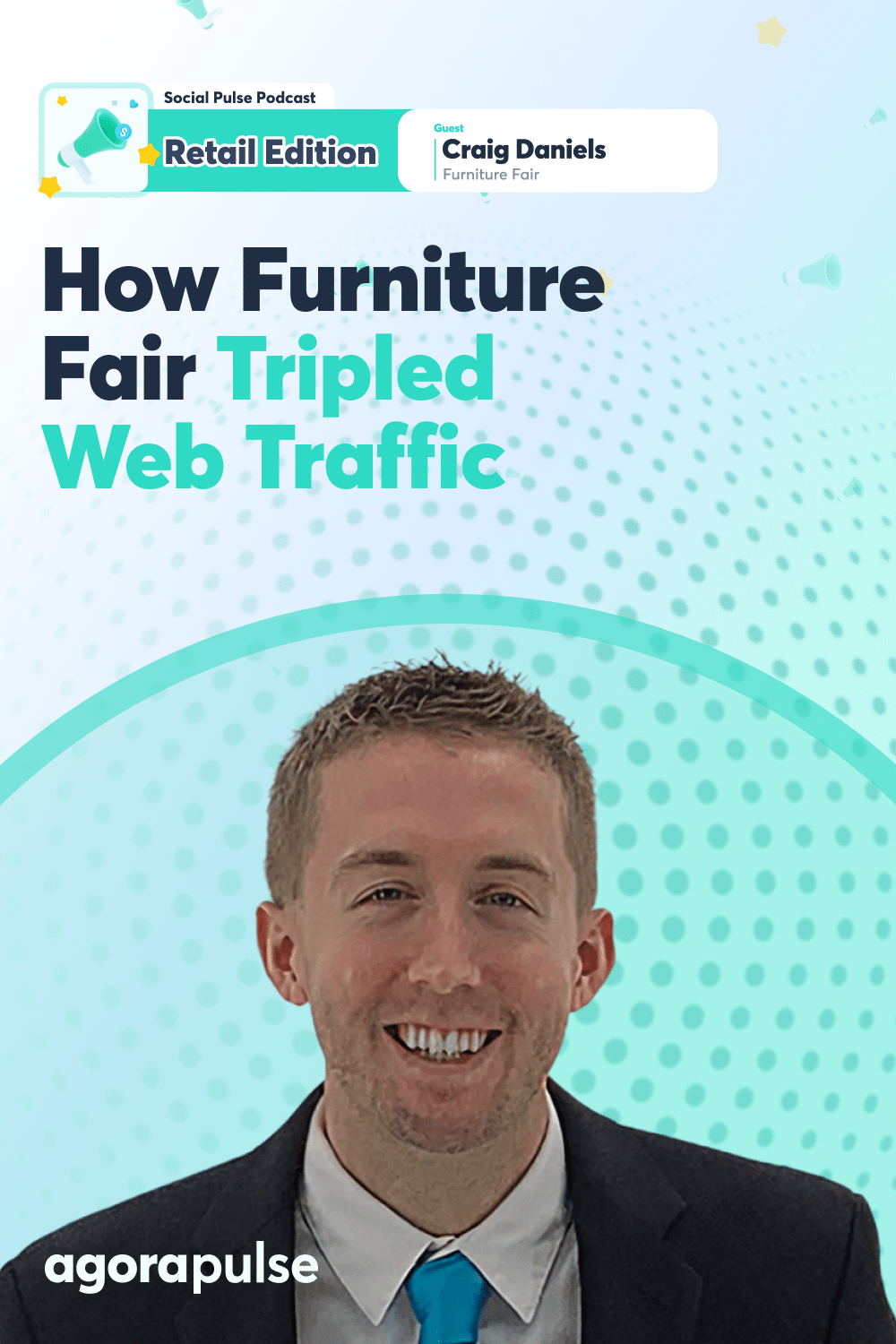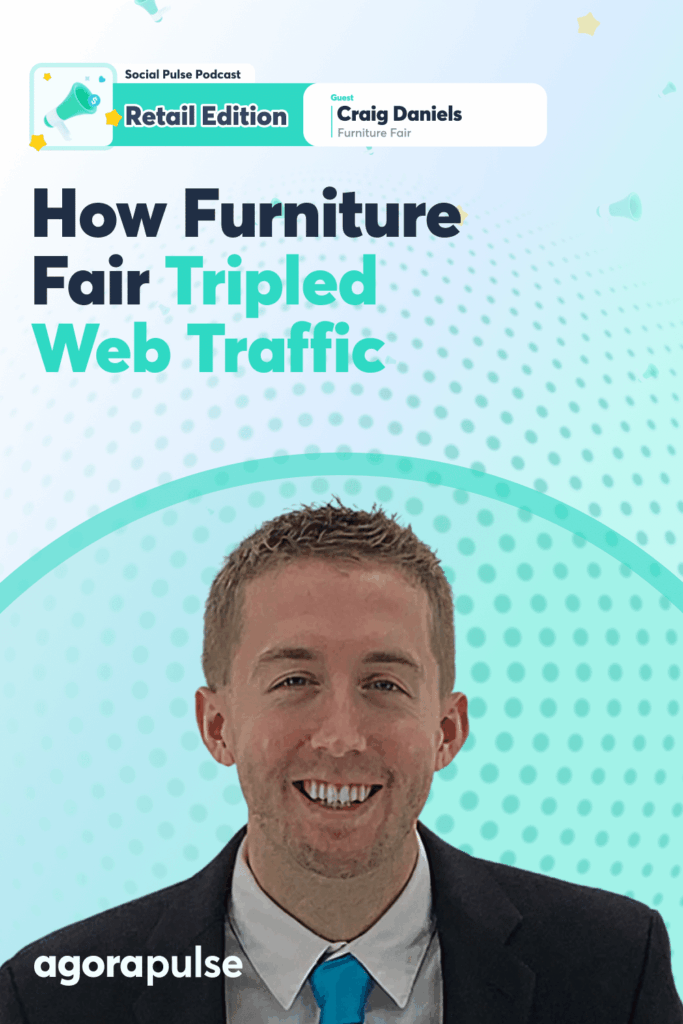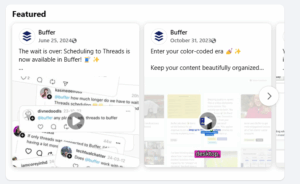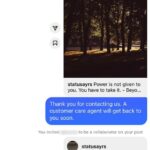Many retailers find themselves stuck in the cycle of discount-driven marketing, wondering if there’s a better way to attract and engage customers. But what if there were a strategy that could not only triple your web traffic but also build lasting customer relationships before they even walked through your doors?
That’s exactly what our guest Craig Daniels achieved as marketing director at Furniture Fair. Taking the helm in January 2020, Craig transformed their marketing approach from traditional promotional advertising to a trust-based content strategy that has revolutionized their customer relationships. His innovative approach to blending educational content with relationship-based selling has not only improved traffic but also increased average order values and customer satisfaction.
[Listen to the full episode below, or get the highlights of the Social Pulse: Retail Edition, powered by Agorapulse. Try it for free today.]
In January 2020, when you took over as marketing director, what was Furniture Fair’s marketing strategy?
Craig Daniels: It was exciting because we had a lot of opportunities to improve, and what we were doing prior was traditional advertising, your print pieces in the newspaper, and TV broadcast, cable, radio, and some direct mail.
So we just wanted to dive into more of the digital space because obviously that’s where a lot of advertising’s going, and that’s where a lot of eyeballs are going, more importantly.
What prompted the shift from “traditional” promotional marketing to an educational content approach?
Craig Daniels: So, in January of 2020, a few executives and I were at a furniture conference in Las Vegas and had the privilege of listening to Marcus Sheridan speak about his book They Ask, You Answer.
Honestly, from the moment of meeting [Sheridan] and getting to know him a little more, content marketing just made sense. It allowed us to do so many things, whether it was build the content on our website, educating our customers, or just educating our salespeople in general.
We were excited about what content could do for us.
What were some of the first steps that you took to implement that?
Craig Daniels: The first steps were reading his book. His book was inspirational, I think, to say the least.
His examples with Yale Appliance out on the East Coast got me more and more interested in them … For those of you who don’t know, they’re a family-owned and operated business similar to us, and they’re retailers selling appliances, which is somewhat similar to furniture as far as price points go.
But I saw them go from a hundred percent traditional advertising to, I can’t remember what the last number they said, less than 20% traditional advertising utilizes content to bolster who they are, their branding aspect, and build trust with the consumer.
To us, relationship-based selling is who we are, and if we could add relationship selling elements into our marketing, that just seemed to be a home run for us, and I’m glad we got the chance to know Marcus.
Even if you meet him, you’ll never see the guy frown. I’ve never not seen Marcus smile. He is always upbeat, energetic, and a blast to talk to.
Mike Allton: And I think it’s important for folks listening, if you’re not familiar, the tenet of They Ask, You Answer is that you’re answering the questions that your target prospects are asking at the middle or the bottom of the funnel. You’re not talking about high-level stuff that most people would consider top of funnel content, you’re trying to hone in on what it is that your buyers are actually wondering, that’s stopping them from pulling the trigger and making that buying decision.
So, the great example that I love from Yale Appliance was how they were talking about the worst appliance manufacturers, the ones that are going to fail the most, because in addition to selling appliances, they also service them. So, they knew which appliances they were serving the most, and their content probably wasn’t very popular with the actual appliance manufacturers because it didn’t paint them in the best light. But it was amazing for the target customers ’cause just imagine if you’re going out there, and you’re trying to buy a new refrigerator for your home, you don’t want to buy the one that’s going to have to be serviced the most. You’d want to lean towards the ones that are serviced the least. But there wasn’t a lot of content out there that would tell you something like that back then. So they’re providing that kind of content.
How did you build and organize a team to maintain that kind of production schedule?
Craig Daniels: So that was the fun part, honestly, getting back from Vegas and signing off with Marcus and his team over at IMPACT of just figuring out, okay, what are the next steps?
And from there, we got to interview a bunch of amazing videographers and then also some writers. So we brought a writer in internally, believe it or not. He was a graphic designer for us for a few years, and said, “I also love to write!” And he built some stuff for us, and we loved it. And then from the videographer standpoint, I feel like that was a home run in and of itself—not only for the content aspect, for consumer-facing, but also internally, more capturing philanthropic events that we’re a part of. We’re capturing internal training, just as we all know, video is king for the time being (before AI changes everything about that).
But just to have someone on staff to capture every single moment was great.
And so when we added those two team members, we worked with the consultants over at IMPACT. They helped teach us not only how to make the content, but also what type of content to make and, more importantly, unbiased content. So that’s by building that unbiased content, you can help build more trust and loyalty with the consumer base, ’cause they know you’re not feeding them just some kind of sales message.
You’re just there to help and build a relationship, build a rapport via the content we’re producing.
Could you give us an example of the content you were creating and how that influenced one of your customers’ journeys from research to purchase?
Craig Daniels: One of my favorite types of content that we’re creating right now is brand reviews, and let’s take Smith Brothers for an example, they’re up in Bern, Indiana. They’re made in the USA, fully manufactured, customized to every detail of your piece, and it just allows us to showcase their brand and all of the benefits and features that they have to offer. Normally, they’re anywhere from a $2,000 to $10,000 sofa. And, by having these content elements to showcase why they are the price that they are, it helps people get over that price hurdle.
And to that point, that’s what content allows us to do. It allows us to showcase our merchandise in a way that is digestible and for the consumer to understand what is best for their needs and their pocketbook.
Did you get your sales team to actively use and embrace this kind of content?
Craig Daniels: Yeah, so we adopted a philosophy called Assignment Selling, which we’re taking our salespeople and using them as teachers for our customers. They’re sending content before, during the process, and only content that is relevant to the consumer.
So, for instance, let’s say they went ahead and wanted to set an appointment to come in and visit one of our showrooms. We’re sending them some content on everything you should know before starting your buying journey, whether that’s measuring the rooms, understanding the colors, you know who’s going into that room, or do you have pets, and then post-purchase. Or we’ve got content such as how to maintain the furniture you just bought. What is next in your buying journey? So if you bought a mattress, maybe an adjustable bed base—if you snore a lot—might be an investment worth making down the road.
So, that’s been a huge plus for us, and the fact that our software engineer and our couple of our staff members were able to build some attribution reporting has been a godsend for understanding the successes, the ROI of this whole program.
Mike Allton: That’s fascinating. I don’t know that I’ve ever heard of a retail environment doing that before, so you’re sending content to the customers before they even come into an in-store experience.
Craig Daniels: Yeah, and it’s primarily obviously having, if we have their information, so if they’re a past customer that we’re reengaging with, or if they come to our website and they go ahead and organically set up an appointment at our showroom. But that’s the important part of Assignment Selling: just getting them more prepared before they walk through that door.
Traditionally, when buyers walk through that retail brick-and-mortar space, I don’t know, 50 to 75% [are] already there in the buying journey. But if we can educate them before that, when they walk through that door, they can be 80 to 90% of the way ready to buy. And so all the salesperson then at that point has to do is guide them to what is best for them because they’re walking in, understanding some of the terminology maybe, or just understanding their needs a little more. And that’s vital.
Are there specific metrics that you’re tracking that identify what is successful beyond just website traffic?
Craig Daniels: Yeah, so metrics and ROI are what make this thing continue.
We built a team when this first started called a revenue team, and we tried to pull from every aspect of who this affects. So we pulled our sales director, our training director, obviously the marketing director, our website manager, as well as someone from merchandising. And so we pulled all of us together and we’re like, “Okay, what are the most important metrics, and what [do] we need to keep track of?” So we came down, narrowed it down to about a list of 35 different metrics that each of us is responsible for, a handful of them each. And it’s helped us keep on track and understand where we are improving, what we are doing, and where we need some more work and improvement.
We’re monitoring that weekly and then meeting monthly to just understand the direction of this program, as well as just where we can improve. But we’re tracking things like sales attribution, obviously web traffic, website leads, videos, content created, online sales orders, average click-through rate, and average position rank on Google.
So just to give you a kind of an idea of where our heads are at when we’re measuring the success for.
Where are you getting ideas for what kind of content to create?
Craig Daniels: A lot of that’s coming from our customers or our salespeople.
Our salespeople are the best resource we can use because they’re our frontline soldiers, so to speak. They’re the ones interacting with our customers on a day-to-day basis. So we meet with our sales management team once a month. So, just go over what you guys are hearing and then also sharing our content wins. Here’s some of the stuff that’s getting the most views. Here’s some of the stuff that’s getting the most attribution, and it’s a team effort between sales and marketing.
Are there any resources or tools that have been particularly helpful to your content strategy?
Craig Daniels: I would say some of the most helpful things have been—obviously, besides the platforms that we’re pushing this content, like social media, our website—it’s tools like SEMrush where we’re able to monitor website score. It’s Google Analytics, so we can understand which pages and which content are getting the most views. And it’s some of our internal dashboards where we’re just measuring attribution after content’s been sent.
All of those have helped us measure and improve what we’re doing here.
Thanks for reading the highlights from this episode with Craig Daniels. Don’t forget to find the Social Pulse Podcast: Retail Edition on Apple or Spotify, where we’re digging into the challenges, successes, and stories of social media and community professionals in the industry, just like you.











